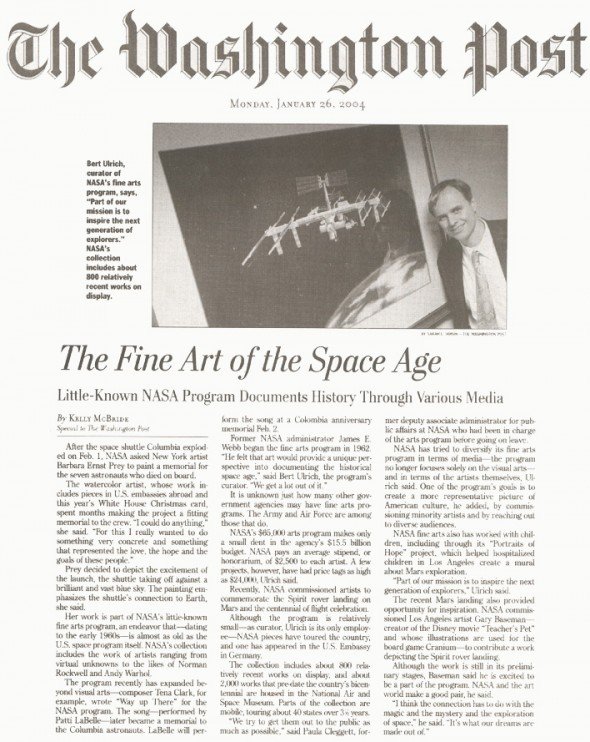The Fine Art of the Space Age
The Washington Post
January 26th, 2004
After the space shuttle Columbia exploded on Feb. 1, NASA asked New York artist Barbara Ernst Prey to paint a memorial for the seven astronauts who died on board.
The watercolor artist, whose work includes pieces in U.S. embassies abroad and this year’s White House Christmas card, spent months making the project a fitting memorial to the crew. “I could do anything,” she said. “For this I really wanted to do something very concrete and something that represented the love, the hope and the goals of these people.”
Prey decided to depict the excitement of the launch, the shuttle taking off against a brilliant and vast blue sky. The painting emphasizes the shuttle’s connection to Earth, she said.
Her work is part of NASA’s little-known fine arts program, an endeavor that- dating to the early 1960s – is almost as old as the U.S. space program itself. NASA’s collection includes the work of artists ranging from virtual unknowns to the likes of Norman Rockwell and Andy Warhol.
The program recently has expanded beyond visual arts- composer Tena Clark, for example, wrote “Way up There” for the NASA program. The song- performed by Patti LaBelle- later became a memorial to the Columbia astronauts. LaBelle will perform the song at a Columbia anniversary memorial Feb. 2.
Former NASA administrator James E. Webb began the fine arts program in 1962. “He felt that art would provide a unique perspective into documenting the historical space age,” said Bert Ulrich, the program’s curator. “We get a lot out of it.”
It is unknown just how many other government agencies may have fine arts programs. The Army and Air Force are among those that do.
NASA’s $65,000 arts program makes only a small dent in the agency’s $15.5 billion budget. NASA pays an average stipend, or honorarium, of $2,500 to each artist. A few projects, however, have had price tags as high as $24,000, Ulrich said.
Recently, NASA commissioned artists to commemorate the Spirit rover landing on Mars and the centennial of flight celebration.
Although the program is relatively small- as curator, Ulrich is its only employee- NASA pieces have toured the country, and one has appeared in the U.S. Embassy in Germany.
The collection includes about 800 relatively recent works on display, and about 2,000 works that pre-date the country’s bicentennial are housed in the National Air and Space Museum. Parts of the collection are mobile, touring about 40 states over 3 ½ years.
“We try to get them out to the public as much as possible,” said Paula Cleggett, former deputy associate administrator for public affairs at NASA who had been in charge of the arts program before going on leave.
NASA has tried to diversify its fine arts program in terms of media – the program no longer focuses solely on the visual arts – and in terms of the artists themselves, Ulrich said. One of the program’s goals is to create a more representative picture of American culture, he added, by commissioning minority artists and by reaching out to diverse audiences.
NASA fine arts also has worked with children, including through its “Portraits of Hope” project, which helped hospitalized children in Los Angeles create a mural about Mars exploration.
“Part of our mission is to inspire the next generation of explorers,” Ulrich said.
The recent Mars landing also provided opportunity for inspiration. NASA commissioned Los Angeles artist Gary Baseman – creator of the Disney movie “Teacher’s Pet” and whose illustrations are used for the board game Cranium – to contribute a work depicting the Spirit rover landing.
Although the work is still in its preliminary stages, Baseman said he is excited to be a part of the program. NASA and the art world make a good pair, he said.
“I think the connection has to do with the magic and the mystery and the exploration of space,” he said. “It’s what our dreams are made out of.”
Image: Bert Ulrich, curator of NASA’s fine arts program, in front of Barbara’s painting of the International Space Station.

